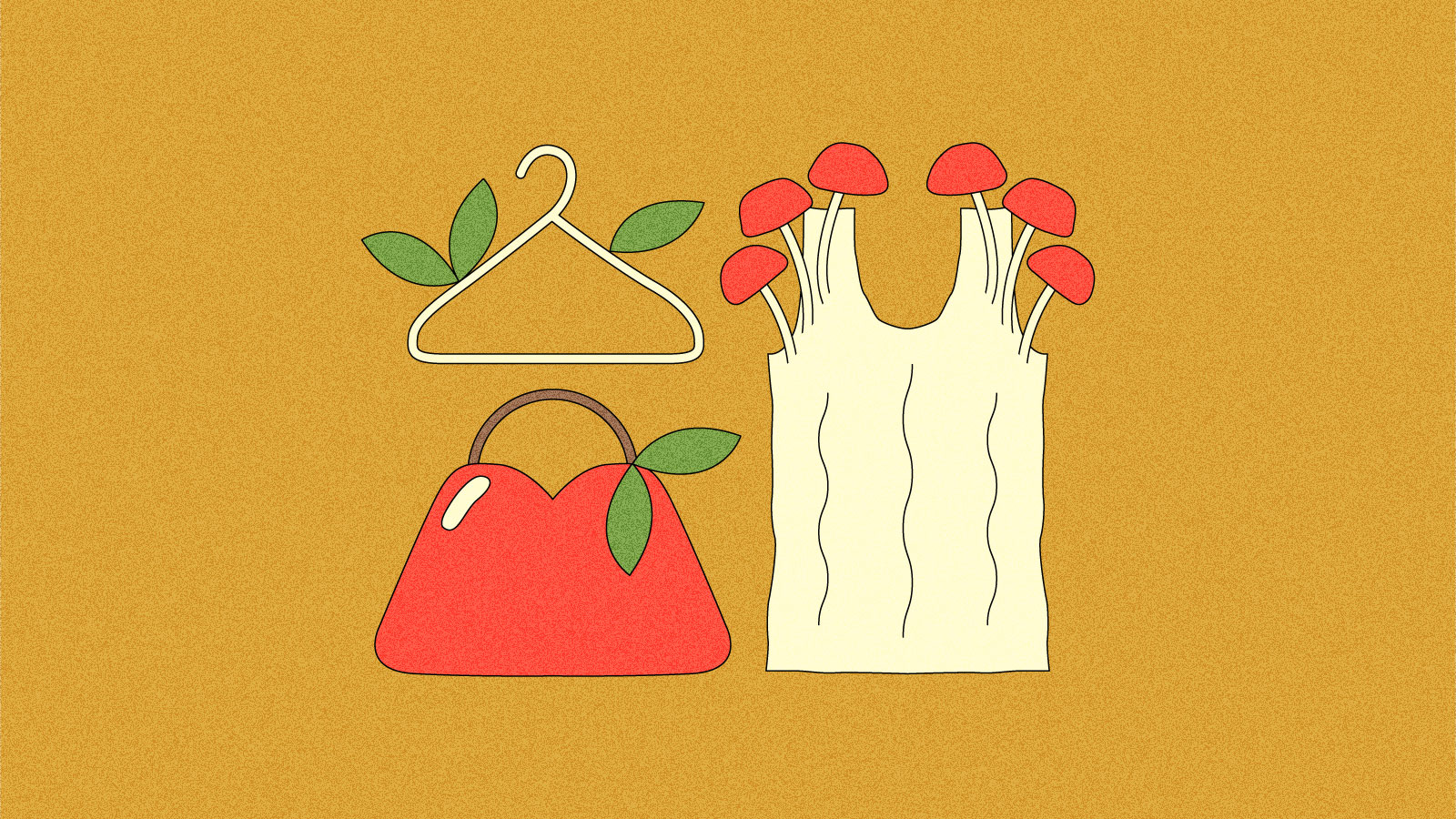Apple waste, spider silk, enhanced cotton: How bio-based textiles could replace plastic in our clothing
Biomaterials companies are using new materials to create high-performance textiles — without plastic.


The spotlight
If you’ve read any climate-related news in the past several years, you’re probably familiar with the scourge of microplastics. These tiny bits of plastic end up clogging oceans. They show up at alarming rates in bottled water, food, clouds — and in the human body. A study published just last month in the journal Toxicological Sciences tested 62 placentas, and found microplastics, in varying concentrations, in every single one. While their long-term impacts on human health are still largely unknown, another study published earlier this month linked microplastics in arteries with increased risk of heart attacks and stroke.
A lot of attention has focused on phasing out single-use plastics, which create visible plastic pollution and release microplastics when they break down. But there’s growing recognition that plastics, and microplastics, are hidden in a staggering number of products we depend on — including, notably, our clothing.
The bits of plastic shed from synthetic textiles have their own term: microfibers. Scraps of polyester, nylon, elastane, and other synthetic fabrics slough off of our clothes in the course of wearing, storing, and washing them. Laundry alone may account for about a third of the microplastics released into the ocean each year — and some innovations and regulations have emerged to reduce the transfer of microplastics from our washing machines to our water systems. But another set of innovators are imagining something bigger: what our clothes could be made of instead.
The problem, of course, is that plastics are so darn functional. Synthetic fibers are typically cheaper to produce than organic materials, and they also offer performance benefits, like stretchiness and weatherproofing.
“The age of plastic began because it mimicked other things, and the functionality was so good that it became its own thing,” fashion designer Uyen Tran told Grist, when we interviewed her for our 2023 Grist 50 list. In 2020, Tran founded a company called TômTex to create bio-based materials that can replace synthetic fabrics as well as leather and suede. She believes that a wave of new materials is ready to outcompete plastic-based textiles. “I think biomaterial is on the edge of becoming its own thing as well. Just give us a few more years, and you will see.”
In this newsletter, we’re rounding up a handful of the materials — from apple waste to artificial spider silk — that are already on the market, offering a glimpse of a plastic-free future for our textiles.
![]()
Shrimp shells: TômTex’s bio fabrics are made out of the waste from mushrooms and shrimp shells. The company sources the latter partially from the shrimp industry in Tran’s native Vietnam, which creates hundreds of tons of shell waste annually. And, Tran noted in her Grist 50 profile, she eventually hopes to build a network of regional production facilities all over the world, sourcing materials from waste streams in different regions. The company debuted its fully biodegradable shell-based fabric at New York Fashion Week in 2022, in a collaboration with designer Peter Do. Its mushroom-based fabric was seen on runways in both London and Paris Fashion Weeks in 2023. Read more
Apple mush: Another example of a company harnessing waste streams as raw materials for textiles is Allégorie, a New York-based accessory company making bags and wallets out of apple pomace — the mush left behind from juicing — as well as cactus, mangos, and pineapple leaves. Co-founder Heather Jiang told Marie Claire that some of the products even retain a pleasant, fruity scent.
Allégorie’s fruit-based products are meant to offer a better vegan leather, as the majority of faux leather products currently on the market are made of plastics like polyurethane and vinyl. The company also sees reducing food waste as part of its mission. Read more
Old cotton: A perhaps less surprising waste stream is used clothing itself. Early last year, a Swedish company called Renewcell opened the world’s first commercial-scale textile-recycling facility, the BBC reports. The company shreds old cotton clothing (with up to 5 percent non-cotton content), like shirts and jeans, and then chemically processes them to separate the fibers, which results in a simple organic compound called cellulose. This can then be spun into new viscose fabric.
The big sell here is reducing textile waste; more than 100 billion clothing items are produced each year, and only 1 percent end up getting cycled into new garments. But the company is using that existing stock instead of plastic to make new clothes — and clothes that in turn won’t create more microplastics. The mill has contracts with a number of suppliers, including Swedish fashion giant H&M. Read more
Enhanced cotton: A company called Natural Fiber Welding is working on enhancing natural materials like cotton to confer some of the same benefits that synthetic fabrics offer. Wired reports on how the process, known as (you guessed it!) “fiber welding,” uses liquid salts to partially break down the fibers and then fuse them together, creating longer and stronger threads that can mimic some of the coveted characteristics of synthetics, like strength and durability, especially relevant for athletic and outdoor apparel. The company announced a partnership with Patagonia in 2021. Read more
Lab-grown spider silk: A Japanese company called Spiber is pioneering what it calls “brewed protein” fibers — a way to produce desirable natural substances in a lab. As The Japan Times reports, it began in 2007 with efforts to engineer spider silk, which has long been admired for its strength, durability, and lightness. (Hence the name, which combines “spider” and “fiber.”) The company’s first product, made from a silk protein synthesized by bacteria enhanced with a snippet of spider DNA, was used in 2015 by The North Face, in a prototype coat called the Moon Parka.
But the company encountered a challenge in trying to create a product that wouldn’t shrink when wet, as spiderwebs do. Today, taking lessons from its initial engineering process, Spiber produces a brewed protein material that does not replicate any specific natural substance. The novel material is now being used by sportswear company Goldwin (the distributor for The North Face in Japan), which hopes to have 10 percent of its new products use brewed protein by 2030. Read more
— Claire Elise Thompson
More exposure
- Read: more about microfibers, and some of the technological and regulatory solutions that could stop them escaping from laundry machines into waterways (Grist)
- Read: an article about “instant fashion” and its heavy dependence on polyester (Harvard Business Review)
- Read: about a mountain of clothing waste that was burned in Chile’s Atacama Desert in 2022 — essentially an oil fire (Grist)
- Read: more about the growth of biomaterials, in clothing and other industries (Dezeen)
A parting shot
Another increasingly common bio-based textile is lyocell. The semi-synthetic fiber, also sometimes known by the brand name Tencel, is famous for its softness and its relative sustainability. It’s made by chemically dissolving wood pulp (usually fast-growing eucalyptus), pushing the mixture through a shower-head-like device called a spinneret, and then spinning the fibers into a yarn. In this photo from The Fashion Awards 2023 in London, Nicole Scherzinger (of Pussycat Dolls fame) wears a custom Tencel gown by Patrick McDowell, a luxury designer who only uses sustainable and recycled fabrics.

This story was originally published by Grist with the headline Apple waste, spider silk, enhanced cotton: How bio-based textiles could replace plastic in our clothing on Mar 13, 2024.
What's Your Reaction?


















































